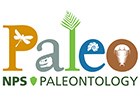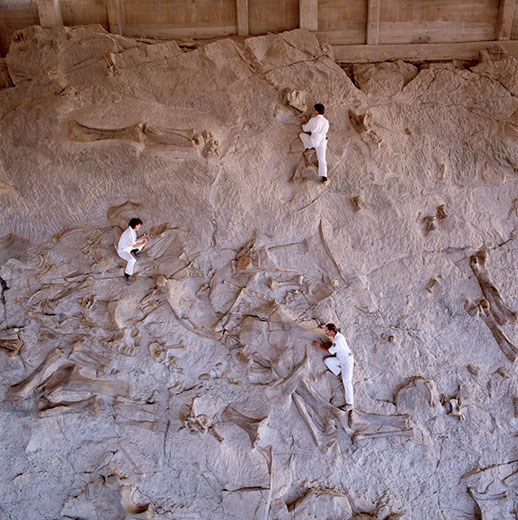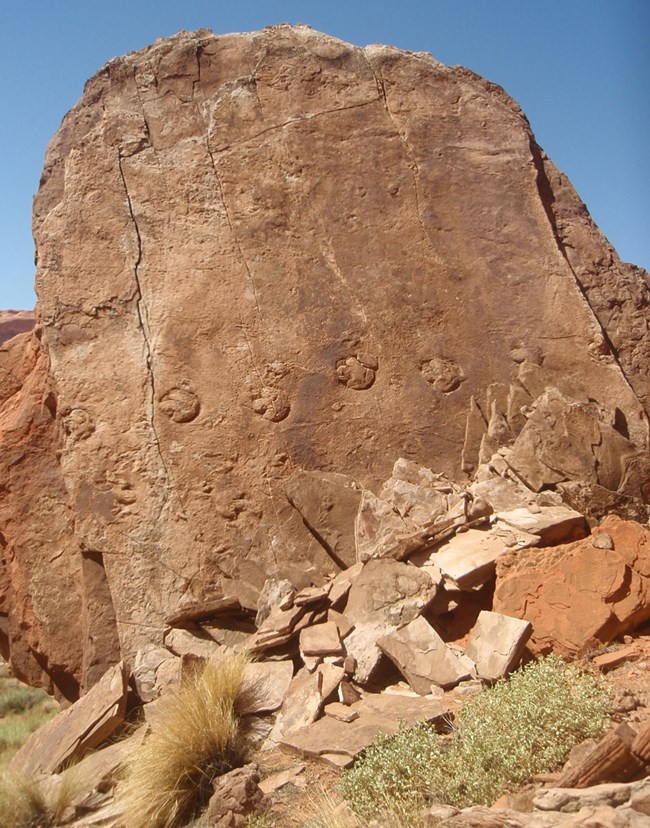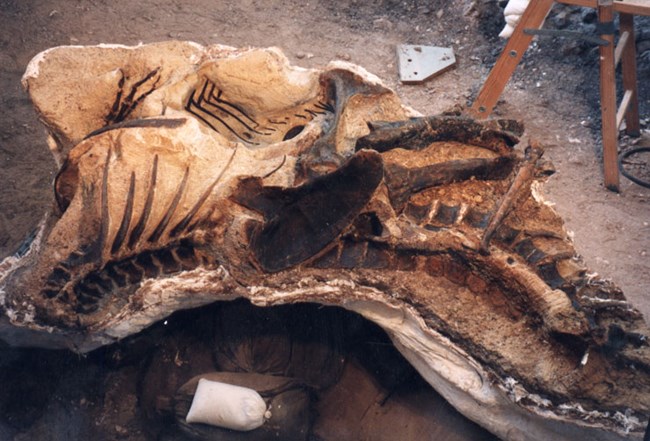Part of a series of articles titled Park Paleontology News - Vol. 10, No. 2, Fall 2018.
Article
Dinosaurs of the National Park Service

Article by Justin Tweet, Paleontologist, American Geosciences Institute
for Park Paleontology Newsletter, Fall 2018

NPS Photo / Vince Santucci
Dinosaurs are among the most popular and iconic fossil organisms, and dinosaur bones and tracks are favorite attractions at several National Park Service units. In recognition of this status, my coauthor Vince Santucci and I prepared an inventory of NPS dinosaurs, due to be published before the end of 2018. [Note: This inventory, An inventory of non-avian dinosaurs from National Park Service areas, is complete and available online.]
As of September 2018, body and trace fossils of non-avian dinosaurs have been documented from at least 21 NPS areas. There are also two NPS areas that are associated with historically significant finds, two NPS areas where dinosaur tracks have been incorporated into building stone, one equivocal report of dinosaur fossils, and one case where dinosaur fossils have been found immediately outside of a NPS area. Together, these fossils document dinosaurs from the Late Triassic (approximately 210 Ma; million years ago) to the end of the Cretaceous (66 Ma). This encompasses everything from some of the earliest known dinosaurs of North America, to desert trackmakers of Early and Middle Jurassic age, to giant sauropods and plate-backed stegosaurs of the Late Jurassic, to as-yet poorly known Early Cretaceous and early Late Cretaceous forms, to tyrannosaurs and titanosaurs at the end of the Cretaceous. Geographically, this record spans across the continental United States, from Big Bend National Park in Texas to Springfield Armory National Historic Site in Massachusetts, and up to Denali National Park and Preserve in Alaska. but is centered on the Colorado.

(Above) A map of NPS units that have yielded dinosaur fossils or are associated with them. 1, Yellowstone NP (National Park); 2, Bighorn Canyon NRA (National Recreation Area); 3, Dinosaur NM (National Monument); 4, Capitol Reef NP; 5, Arches NP; 6, Canyonlands NP; 7, Bryce Canyon NP; 8, Zion NP; 9, Glen Canyon NRA; 10, Rainbow Bridge NM; 11, Pipe Spring NM; 12, Navajo NM; 13, Petrified Forest NP; 14, Colorado NM; 15, Curecanti NRA; 16, Mesa Verde NP; 17, Chaco Culture NHP (National Historical Park); 18, Yukon-Charley Rivers NP (National Preserve); 19, Denali NP&P (National Park & Preserve); 20, Wrangell-St. Elias NP&P; 21, Katmai NP&P; 22, Aniakchak NM&P (National Monument and Preserve); 23, Big Bend NP; 24, Lewis & Clark NHT (National Historic Trail); 25, Springfield Armory NHS (National Historic Site); 26, Valley Forge NHP; 27, Gettysburg NMP (National Military Park).
The first report of dinosaurs associated with places that would one day be protected in the National Park Service goes back to the Lewis and Clark expedition (Lewis & Clark National Historic Trail), when on July 25, 1806, William Clark found a large bone near Pompey’s Pillar in Montana, likely from a dinosaur. The study of dinosaurs in North America began in earnest in the 1850s, and one of the first specimens to include more than a bone or two was recovered from Springfield Armory in 1855. This specimen was described as a small herbivore, Megadactylus polyzelus (renamed Anchisaurus). Probably the most significant event for the study of dinosaurs in NPS areas was Earl Douglass’s discovery of what would become the Dinosaur Quarry on August 17, 1909, eventually leading to Dinosaur National Monument in Colorado and the famous quarry wall display. To the south, expeditions to collect dinosaur fossils in the future Big Bend National Park began in the 1930s. Dinosaur-related scientific work has been increasing in the NPS since the late 1970s and has yielded significant track finds in Alaska and the Colorado Plateau.

NPS Photo
Dinosaurs from Triassic rocks (252 to 201 Ma) in the NPS are best known from Petrified Forest National Park in Arizona, which has most of the few Triassic dinosaur body fossils from the NPS. The park’s Triassic dinosaurs were “supporting players” in an ecosystem dominated by crocodile-like phytosaurs, armored aetosaurs, and giant amphibians. Other Triassic NPS dinosaurs are known almost entirely from tracks, mostly representing small three-toed predators. At Gettysburg National Military Park and Valley Forge National Historical Park, both in Pennsylvania, visitors may see Triassic dinosaur tracks in locally quarried building stone.

NPS Photo
The Jurassic (201 to 145 Ma) record of dinosaurs in the NPS is largely confined to the Colorado Plateau and Yellowstone area. Most finds can be put into one of two categories: tracks from rocks of Early (201 to 174 Ma) or Middle Jurassic age (174 to 163 Ma), or body fossils from the Morrison Formation, of Late Jurassic age (163 to 145 Ma). Jurassic dinosaur tracks have been found in many of the NPS units of the Colorado Plateau, and more are being found every year due to increased interest. These tracks are important because the host rocks have few body fossils, so the tracks are our only evidence of the dinosaurs. Tracks of small to large three-toed predators are most abundant. The Morrison Formation is known worldwide for its fossils of dinosaurs, from predators such as Allosaurus and Ceratosaurus, to enormous sauropods such as Apatosaurus, Brachiosaurus, Brontosaurus, Camarasaurus, and Diplodocus, to the bipedal herbivore Camptosaurus and plated Stegosaurus. The Dinosaur Quarry of Dinosaur National Monument is one of the most productive dinosaur sites in the Morrison Formation, and has yielded skeletons that are mounted in many museums. Several other parks also have Morrison Formation fossils, mostly in Colorado and Utah, but as far northwest as Yellowstone National Park.

NPS Photo
Cretaceous (145 to 66 Ma) dinosaurs in the NPS are not as easily categorized as the Triassic and Jurassic examples. In recent years, Alaska’s parks have become significant for tracks, especially at Denali National Park and Preserve, where hadrosaur tracks are abundant. Bryce Canyon National Park, in Utah, has a notable record of microfossils from early Late Cretaceous rocks that have otherwise yielded few dinosaur fossils. Several parks have records of dinosaurs that lived near the Western Interior Seaway, a continental sea that submerged much of North America from the Gulf Coast to the Canadian Arctic between approximately 100 and 70 Ma. Significant discoveries have been made in the rocks deposited just before the advance of the seaway at Arches National Park in Utah, and Dinosaur National Monument, including skulls of the sauropod Abydosaurus at Dinosaur National Monument. The most extensive Cretaceous dinosaur fossil record comes from Big Bend National Park, where rocks from the Late Cretaceous hold fossils similar to those from southern Canada, Montana, and nearby areas. At Big Bend, there were tyrannosaurs, horned dinosaurs, hadrosaurs, the giant sauropod Alamosaurus, and others, many of which we’ve only learned about in the past few decades.

NPS Photo.

NPS Photo
Discoveries and research have increased greatly since the 1970s and ‘80s. For example, fifteen dinosaur species have been named from fossils recovered from sites now within NPS areas; of these, twelve have been named since 1988, including one species (Dryosaurus elderae, honoring deceased NPS paleontologist Ann Elder) named from Dinosaur National Monument after our inventory went to press.
Featured Parks
-
Aniakchak National Monument and Preserve, Alaska—[Geodiversity Atlas] [Park Home] [npshistory.com]
-
Arches National Park, Utah—[Geodiversity Atlas] [Park Home] [npshistory.com]
-
Big Bend National Park, Texas—[Geodiversity Atlas] [Park Home] [npshistory.com]
-
Bighorn Canyon National Recreation Area, Montana and Wyoming—[Geodiversity Atlas] [Park Home] [npshistory.com]
-
Bryce Canyon National Park, Utah—[Geodiversity Atlas] [Park Home] [npshistory.com]
-
Canyonlands National Park, Utah—[Geodiversity Atlas] [Park Home] [npshistory.com]
-
Capitol Reef National Park, Utah—[Geodiversity Atlas] [Park Home] [npshistory.com]
-
Chaco Culture National Historical Park, New Mexico—[Geodiversity Atlas] [Park Home] [npshistory.com]
-
Colorado National Monument, Colorado—[Geodiversity Atlas] [Park Home] [npshistory.com]
-
Curecanti National Recreation Area, Colorado—[Geodiversity Atlas] [Park Home] [npshistory.com]
-
Denali National Park, Alaska—[Geodiversity Atlas] [Park Home] [npshistory.com]
-
Dinosaur National Monument, Colorado & Utah—[Geodiversity Atlas] [Park Home] [npshistory.com]
-
Gettysburg National Military Park, Pennsylvania [Geodiversity Atlas] [Park Home] [npshistory.com]
-
Glen Canyon National Recreation Area, Arizona & Utah—[Geodiversity Atlas] [Park Home] [npshistory.com]
-
Katmai National Park, Alaska—[Geodiversity Atlas] [Park Home] [npshistory.com]
-
Lewis and Clark National Park, Oregon and Washington—[Geodiversity Atlas] [Park Home] [npshistory.com]
-
Mesa Verde National Park, Colorado—[Geodiversity Atlas] [Park Home] [npshistory.com]
-
Navajo National Monument, Arizona—[Geodiversity Atlas] [Park Home] [npshistory.com]
-
Petrified Forest National Park, Arizona—[Geodiversity Atlas] [Park Home] [npshistory.com]
-
Pipe Springs National Monument, Arizona—[Geodiversity Atlas] [Park Home] [npshistory.com]
-
Rainbow Bridge National Monument, Utah—[Geodiversity Atlas] [Park Home] [npshistory.com]
-
Springfield Armory National Historic Site, Massachusetts—[Geodiversity Atlas] [Park Home] [npshistory.com]
-
Valley Forge National Historical Site, Pennsylvania [Geodiversity Atlas] [Park Home] [npshistory.com]
-
Wrangell-St Elias National Park, Alaska—[Geodiversity Atlas] [Park Home] [npshistory.com]
-
Yellowstone National Park, Idaho, Montana, Wyoming—[Geodiversity Atlas] [Park Home] [npshistory.com]
-
Yukon-Charley Rivers National Park, Alaska—[Geodiversity Atlas] [Park Home] [npshistory.com]
-
Zion National Park, Utah—[Geodiversity Atlas] [Park Home] [npshistory.com]
Tags
- aniakchak national monument & preserve
- arches national park
- big bend national park
- bighorn canyon national recreation area
- bryce canyon national park
- canyonlands national park
- capitol reef national park
- chaco culture national historical park
- colorado national monument
- curecanti national recreation area
- denali national park & preserve
- dinosaur national monument
- gettysburg national military park
- glen canyon national recreation area
- katmai national park & preserve
- lewis and clark national historical park
- mesa verde national park
- navajo national monument
- petrified forest national park
- pipe spring national monument
- rainbow bridge national monument
- springfield armory national historic site
- valley forge national historical park
- wrangell - st elias national park & preserve
- yellowstone national park
- yukon - charley rivers national preserve
- zion national park
- geology
- fossils
- paleont
- dinosaurs
Last updated: August 19, 2024
